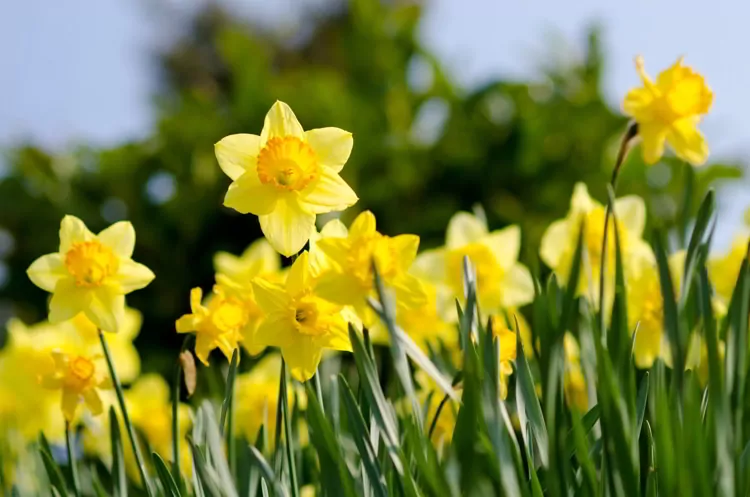An Intelligence Investment
One of my fondest memories as a child is standing in a seemingly endless sea of yellow daffodils.
My aunt had planted a handful of bulbs years before, and every year, with careful hands, she and I split the clumps and expanded the daffodil patch until they took over almost the entire country garden.
I remember it vividly to this day, but my aunt does not. She has Alzheimer’s and doesn’t remember anything anymore… Neither her family nor her flowers.
It’s a truly devastating disease… a thief of your memories, your dignity, and eventually your humanity.
Alzheimer’s affects several members of my family, so it’s something I’m scared of, too.
There is no known cure, but I recently learned that there is a treatment that can delay its progression…
A treatment that can allow a sufferer priceless years of extra time with their loved ones.
When I found out where this treatment originated, I couldn’t help but smile…
The best hope for sufferers comes not from chemical factories or pharmaceutical labs but from daffodils grown in a garden like that of my aunt all those years ago.
The Disease
Alzheimer’s is “a brain disorder that slowly destroys memory and thinking skills, and, eventually, the ability to carry out the simplest tasks,” according to the National Institute of Health.
While we don’t yet understand what triggers it, we know that its physiological symptoms include the development and spread of abnormal amyloid and tau proteins in the brain, as well as changes in brain structure and function.
Fifty million people around the globe have been diagnosed with Alzheimer’s. Countless more cases are undiagnosed.
Six of the 50 million are in the United States. With the aging U.S. population, that figure is expected to increase to 16 million by 2050.
The estimated annual cost of treating Alzheimer’s patients in the States is currently US$290 billion.
The Science
A natural alkaloid called galantamine is the ingredient in the humble daffodil that staves off Alzheimer’s progression. It inhibits the breakdown of acetylcholine in your brain.
Acetylcholine is a neurotransmitter that carries messages from your brain throughout your body.
Galantamine is difficult and extraordinarily expensive to produce in a lab. When it is produced in a lab, it has some unpleasant side effects…
The synthetic drug is sold by prescription under the names Razadyne or Reminyl.
Galantamine occurs in tiny amounts in certain plants naturally, especially snowdrops and daffodils. Natural galantamine is considered superior to its synthetic cousin because it has far fewer side effects.
Because galantamine is so hard to produce, doctors are excited by the results of combining natural and synthetic galantamine.
This mix has proven to have much milder side effects and better outcomes for patients.
The only problem is that we produce only a small fraction of the amount of natural galantamine required for this process. Current methods of cultivation simply yield too little…
Does It Work?
This isn’t some homeopathic remedy. It’s backed by real science.
Galantamine has been authorized by the FDA as a treatment for mild and moderate Alzheimer’s since 2004.
Peer-reviewed scientific studies have proven it to be one of the only effective treatments to slow the disease’s progression.
According to one study on the long-term effect of galantamine on cognitive function in patients with Alzheimer’s disease, “When efficacy was assessed on a patient-by-patient basis, about 71% of the patients showed significantly better cognitive function at 72 weeks compared with the predicted outcome” (Nakagawa et al, 2017).
I’ll say that again… 71% of subjects had significantly better cognitive function… This is a miracle result for those with Alzheimer’s and their families.
Natural Galantamine’s Production Cycle
As my aunt taught me almost 40 years ago, daffodils reproduce primarily by bulb rhizome growth and splitting rather than from seed.
This means the underground bulbs split and multiply over time, a bit like how a planted clove of garlic turns into a new bulb the next year.
To prevent overcrowding, you dig these new bulbs out every two years and plant them where you have more space.
Daffodil rhizomes grow slowly compared to onions, for instance.
They expand in volume by a factor of between 1.25 and 2.25 every two years, so expanding the seed stock to sufficient levels to supply global needs is a slow and careful process that will take seven years.
The Opportunity
It’s a rare pleasure when you can invest in something that both makes you money and contributes to society.
Giving those diagnosed with this dreadful disease an extra year of functional life is an amazing gift. With studies proving efficacy for up to five years, this is almost a miracle.
An agricultural developer that I’ve worked with for the past 15 months has devised a way to grow natural galantamine efficiently and cost-effectively.
He’s also well on his way to cornering the market, too.
For the past eight years, he has been carrying out research and development on a specific type of daffodil that is richer in galantamine.
He’s spent US$1.5 million on research and development in the last two years alone.
He bought up 460 tons—all the available supply—of Carlton daffodil bulbs, which are especially rich in galantamine.
With careful breeding and selection, he has cultivated 800 tons of valuable seed stock, which he will harvest in the U.K. in August 2023.
He intends to replant these to expand his supply of bulbs with the intention of cornering the natural galantamine market in the next seven years.
To reach an efficient level of operation, the developer needs at least 2,400 tons of bulbs per year to produce sufficient amounts of galantamine.
The quicker he can increase the amount of his seed stock (daffodil bulbs), the quicker he can reach the level of production he needs to supply the global market.
As a result, he needs capital to expand his production operation rapidly.
That’s why he is inviting Live And Invest Overseas investors in on the action.
He’s offering you a small percentage of the bulbs to generate cash flow for further expansion.
This developer has a great track record of using innovative new methods to successfully produce niche, high-end agricultural products.
He will plant the galantamine-rich seed stock and harvest bulbs every year, starting from year three.
He will keep a small percentage to be sold for cash flow and investor returns and replant the rest until he has enough seed stock to supply the global demand.
From year seven, the company will have sufficient seed stock and will be in a position to buy back your bulbs at premium rates.
Projected Returns
The developer is basing his return projections on the proven ability of prime Carlton daffodils to produce galantamine at a rate of 0.5 kilograms per ton of raw bulbs.
The research and development over the last eight years has proven that well-grown Carlton bulbs can produce up to 1 kilogram per ton, making the below income projections conservative.
Synthetic galantamine is sold for US$27,000 per kilogram, and our natural galantamine will be sold for more.
This means galantamine is worth half its weight in gold… making it one of the most valuable (legal) agricultural products or derivatives in the world.
Will Patients And Insurance Companies Pay For It?
Given the high price of raw galantamine, is this treatment cost-effective?
Studies estimate that a one-year delay in the onset of Alzheimer’s would mean almost a million fewer prevalent cases in the United States. This translates to an estimated annual spending reduction of US$163 billion.
Despite the high cost of the treatment, U.S. insurance companies will pay it to offset the astronomical cost of caring for and treating full-blown Alzheimer’s patients.
The Return On Your Investment
Aside from the personal satisfaction that comes from knowing that your investment helped extend the quality of life of millions of sufferers by up to and beyond five years, this investment has the potential to be very profitable for you, too.

The investment term lasts seven years until the developer reaches the critical mass of bulbs needed to supply the pharmaceutical industry.
The plan is to harvest some bulbs for cash flow every year starting in year three through year seven and to buy back your seed stock at the end of year seven and start of year eight.
The IRR on the 2-ton bulb deal for US$92,530 is an impressive 14% on this medium-term investment.
To talk to our in-house advisors about this ultra-ethical, medium-term, high-yielding investment, go here.
Sincerely,
Con Murphy
Editor, Overseas Property Alert



